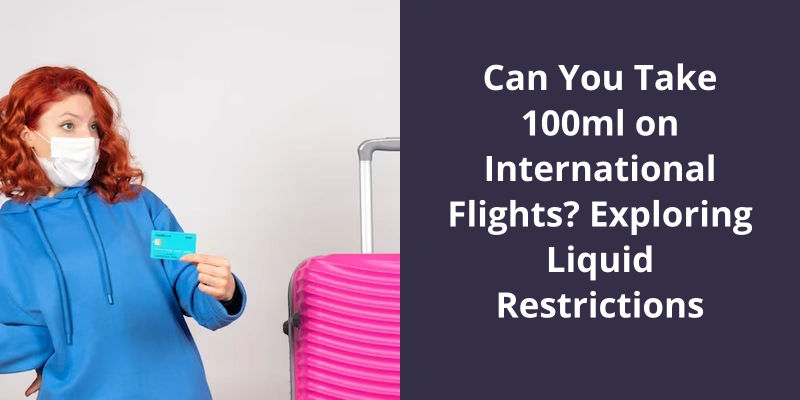Yes, you can take 100ml containers on international flights. There’s a rule set by many airlines, often referred to as the 100-100 rule. According to this rule, you’re allowed to bring liquids in containers of 100 milliliters or less, all packed together in one clear, re-sealable plastic bag of not more than one liter capacity per passenger. Just remember to place this bag separately at the security check for examination. Be aware that restrictions might vary depending on the airline you are flying with or the country you are flying to.

Can You Travel Internationally With 100ml?
Can you travel internationally with 100ml? For international flights, all liquids stored in containers with a capacity exceeding 100 ml(g) are prohibited from being brought onto the aircraft. These restrictions have been put in place by airport authorities and airline security in order to ensure passenger safety and prevent potential threats of terrorism. It’s important to comply with these regulations in order to have a hassle-free travel experience.
When it comes to carrying liquids in your carry-on baggage, it’s crucial to remember the 100ml rule. Any liquid, gel, or aerosol that exceeds this limit must be packed in checked baggage or disposed of before going through security. This includes common items such as toiletries, drinks, and perfumes. It’s worth noting that containers larger than 100 ml, even if they aren’t full, aren’t allowed in carry-on luggage.
To comply with these liquid restrictions, passengers have several options. One option is to transfer the contents of their larger containers into smaller ones with a capacity of 100 ml or less. Another option is to purchase travel-sized versions of their favorite liquids, as these are typically within the allowable limit. Additionally, some airports offer the option to purchase duty-free liquids after the security checkpoint, which can be carried onto the aircraft.
Furthermore, it’s essential to pack all liquids in a clear, resealable plastic bag, such as a ziplock bag, to facilitate the security screening process. This ensures that the liquids are easily visible and separate from the rest of the carry-on items. Each passenger is typically allowed one plastic bag containing their liquids, with a maximum capacity of one liter. It’s advisable to place this bag in an easily accessible location in your carry-on, as it may need to be presented separately during security checks.
It’s important for travelers to be aware of these restrictions and pack their liquids accordingly. By following the guidelines provided by airport authorities and airline security, passengers can ensure a smooth and efficient travel experience, while prioritizing their safety and the safety of others.
Tips for Packing and Organizing Liquids in Your Carry-on Baggage
- Make sure all liquids are stored in containers that are no larger than 3.4 ounces or 100 milliliters.
- Place all liquid containers in a clear, quart-sized plastic bag.
- Remember to seal the bag to prevent any leakage.
- Keep in mind that each passenger is allowed only one quart-sized bag.
- Place the bag in an easily accessible part of your carry-on for easy retrieval during security checks.
- Consider using travel-sized containers for essential liquids to save space.
- Double-check that all lids and caps are tightly closed to avoid any spills.
- If you’ve larger quantities of liquids, consider checking them in your checked baggage.
- If you need to bring medications or medical liquids, have the necessary documentation or prescriptions readily available.
- Familiarize yourself with the airline’s specific rules and regulations regarding liquids before your flight.
One common concern when packing for a flight is whether or not it’s allowed to bring multiple 100ml bottles. The good news is that as long as each bottle remains under 100ml, you can bring as many of them as you need. However, it’s important to note that you’ll still need to be able to fit all of the bottles comfortably into the one resealable plastic bag required for carry-on liquids. This rule offers a bit of leeway if you need to take more than 100ml with you on your journey.
Can I Bring Multiple 100ml Bottles on a Plane?
When it comes to international flights, the rules regarding liquid restrictions can be quite strict. Many travelers wonder if they can bring multiple 100ml bottles on a plane. The good news is that as long as each bottle remains under 100ml, it doesn’t matter if you’ve multiple ones with you. However, it’s important to note that you’ll still need to be able to fit them all comfortably into the one resealable plastic bag that’s typically required for liquids.
This can be especially beneficial for those who rely on certain medications or have to bring specific personal care products. However, it’s crucial to ensure that you aren’t exceeding the allowed liquid volume for the entire bag. The resealable plastic bag is usually limited to a maximum capacity of one liter or around 34 ounces.
In addition to the 100ml restriction per container, it’s also important to keep in mind that all the containers must fit comfortably within the resealable plastic bag. This means that you may need to arrange and organize the bottles efficiently to maximize the space. It’s advisable to invest in travel-sized toiletries or transfer your preferred products into smaller bottles to ensure compliance with the regulations.
Airport security personnel are responsible for enforcing these liquid restrictions, so it’s essential to follow their guidelines to prevent any issues during the security screening process. Being fully aware of the liquid restrictions and organizing your items accordingly will make your travel experience smoother and hassle-free.
The introduction of the 100ml rule at airports in 2006 was a direct response to a thwarted terrorist plot involving liquid explosives. By limiting the amount of liquids that passengers can carry onto planes, the rule aims to enhance security and prevent similar attacks in the future.
Why Do Airports Only Allow 100ml?
The 100ml rule that restricts the amount of liquids allowed on international flights serves a crucial purpose in airline security. In 2006, a major terrorist plot was uncovered, revealing a plan to smuggle liquid explosives onto an aircraft. This revelation prompted the implementation of the 100ml rule as a preventive measure against similar attacks. The primary objective behind this rule is to minimize the risk of liquid-based explosives being brought on board, which could potentially endanger the lives of passengers and crew.
The rule also enables security personnel to focus their efforts on other potential threats by reducing the need for extensive examination of every single liquid brought on board. Rather than examining numerous larger containers, they can concentrate on scrutinizing the limited number of small containers that comply with the liquid restrictions. This targeted approach enhances the overall effectiveness of security measures while maintaining efficient operations at airports.
It’s part of a wider range of security measures that continually evolve to adapt to emerging threats and maintain the integrity of air travel. While it may seem restrictive, the 100ml rule represents a balanced approach that prioritizes the security and well-being of passengers and crew.
Comparison of Liquid Restrictions in Different Countries or Regions
- United States:
- Canada:
- European Union:
- United Kingdom:
- Australia:
- China:
- Japan:
- South Korea:
- India:
Source: Why can’t one take more than 100 ml of fluids in one bottle …
Conclusion
In conclusion, when it comes to carrying liquids on international flights, the restriction of 100ml or 3.4 oz is a general rule that applies to most situations. However, there are exceptions for duty-free liquids purchased internationally and carried in secure, tamper-evident bags. If you’re travelling to the United States on a connecting flight and have duty-free liquids exceeding 100ml, you can still bring them in your carry-on bag. It’s important to note that this exception only applies to inbound international flights.





